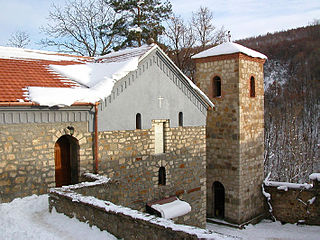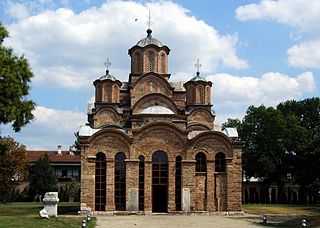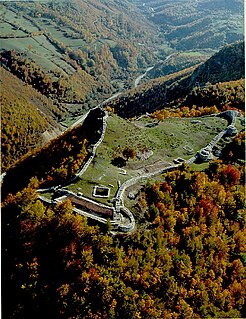 W
WBorač, also known as Borač na Kršu is a medieval town and fortress. The remains of the Borač fortress lie on top of a rocky hill 10 km northwest of Knić.
 W
WThe Church of Holy Apostles Peter and Paul, known as the Cave Church, is a Serbian Orthodox cave-church located on eastern slope of Mount Kopaonik near Lukovo, southern Serbia. it was built by the Serbian King Milutin in the 14th century and is dedicated to Saints Peter and Paul. It is part of the Monastery of St. Archangel Gabriel.
 W
WThe Church of the Holy Apostles Peter and Paul, commonly known as Church of St Peter or simply Peter's Church is a Serbian Orthodox church, the oldest intact church in Serbia and one of the oldest ones in the region, situated on a hill of Ras, the medieval capital of the Serbian Grand Principality (Rascia), in Novi Pazar, Serbia. It is part of the Stari Ras complex, an UNESCO World Heritage Site.
 W
WDevič is a Serbian Orthodox abbey in Kosovo. It was built in 1434 and is dedicated to St Joanikije of Devič. Devič was declared Monument of Culture of Exceptional Importance in 1990, and it is protected by the Republic of Serbia.
 W
WKovin fortress is a strategic fortification in south-western Serbia, 9 km north from the present day town of Prijepolje, between the villages of Džurovo, Kučin, and Izbičanj. The remains are located on a steep rock overlooking the Lim gorge from the left bank, on 698 meters of altitude.
 W
WKoznik Castle is a medieval castle in central Serbia, 10 km northwest from the present day town of Brus, on a hillside of mountain Kopaonik, on the right bank in the upper flow of river Rasina. The castle was built on top of a steep hill dominating the surrounding terrain on 920 m altitude.
 W
WKruševac Fortress or City of Prince Lazar was a medieval fortified town in Kruševac, Serbia, former capital of Prince Lazar. The city housed the court church, Lazarica. Today, all that remains of the town are ruins.
 W
WChurch of the Holy First Martyr Stephen, better known as the Lazarica Church, is a Serbian Orthodox church in Kruševac, Serbia. It was built in 1375-1378 as an endowment of prince Lazar of Serbia. Lazarica, as an outstanding achievement of the Serbian medieval architecture, was declared a Monument of Culture of Exceptional Importance in 1979, and it is protected by the Republic of Serbia. Lazarica was built as a prototype of the Morava school of architecture, as a palace church associated with the Kruševac Fortress, the capital of Prince Lazar. Today, only Lazarica and parts of the keep remain from the vast fortress complex.
 W
WMaglič is a 13th-century castle about 20 km south of Kraljevo, Serbia. The castle is located atop a hill around which the Ibar river makes a curve, about 100 m above the river. The fortress protected the only road that connected the Great Morava Valley and Kosovo polje. Its name means The Foggy One from the Serbian word "Magla" (Магла), meaning fog.
 W
WMramorje or Bagruša (Багруша) is a medieval necropolis, located in Perućac, Serbia, and is among the best preserved necropoli of the region. The necropolis was built in the 14th century, and extends between the Drina river and the main road that follows its course, at the entrance of the settlement. The site is protected by the Republic of Serbia, as a Monument of Culture of Exceptional Importance, but is nevertheless threatened by the Drina river on one side and the continued expanding of the town of Perućac, on the other. Stećaks was inscribed as a UNESCO World Heritage Site in 2016, of which 3 sites are located in Serbia, Mramorje being one of them.
 W
WOstrvica or Ostrovica was a small fortified town built on one of the peaks of Rudnik mountain, 4 kilometres (2.5 mi) northwest of the town of Rudnik. After 1323/1324, when it was recorded for the first time, it belonged to the Kingdom of Serbia, Serbian Empire, Moravian Serbia, Serbian Despotate and Ottoman Empire. In 1451 the Ottomans razed it to the ground.
 W
WMomchilov grad is situated in Pirot, Serbia. It was built in the 14th century by Bulgarian brigand and local ruler Momchil. In 1344, the regency concluded a further alliance with Bulgaria, which required the surrender of Philippopolis (Plovdiv) and nine other towns in northern Thrace along the river Evros. Nevertheless, after their occupation, Ivan Alexander refrained from direct action against John VI Kantakouzenos' forces operating in southern and eastern Thrace. At the same time, Momchil, a former brigand whom Kantakouzenos had entrusted with control over the Merope (region) in the Rhodope mountains, switched over to the regency. It was supposed to serve as a defense against the Turks on the busy road which led from Belgrade to Constantinople.
 W
WThe Serbo-Byzantine architectural style or Vardar architectural school, is an ecclesiastical architectural style that flourished in the Serbian Late Middle Ages, during the reign of the Nemanjić dynasty. It was developed through fusing contemporary Byzantine architecture and the Raška architectural school to form a new style; by the mid-14th century the Serbian state had expanded to include southern Macedonia, Epirus and Thessaly up to the Aegean Sea. On these new territories Serbian art was even more influenced by the Byzantine art tradition. The architectural school was also promoted as a counter to the dominance of Western styles such as Neo-Baroque.
 W
WSoko Grad, also known as Sokolac, is a medieval city and fortress 2 km east of the spa town of Sokobanja, Serbia. The fortress was declared a Monument of Culture of Great Importance in 1982, and it is protected by Republic of Serbia.
 W
WRas, known in modern Serbian historiography as Stari Ras, is a medieval fortress located in the vicinity of former market-place of Staro Trgovište, some 11 km west of modern day city of Novi Pazar in Serbia.
 W
WVršac Castle formerly known as "Vršac Tower" is a medieval fortress near Vršac, Vojvodina, Serbia. Only Donjon tower remained from the entire complex, but in 2009 reconstruction started, to recreate the entire Vršac Castle.